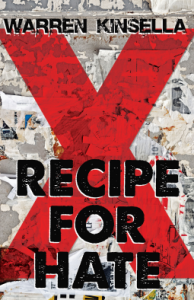
Warren Kinsella
Dundurn Press
Published on October 21, 2017

Amazon | Barnes & Noble | Goodreads
About Recipe for Hate
The X Gang is a group of punks led by the scarred, silent, and mostly unreadable Christopher X. His best friend, Kurt Blank, is a hulking and talented punk guitarist living in the closet. Sisters Patti and Betty Upchuck form the core of the feminist Punk Rock Virgins band, and are the closest to X and Kurt. Assorted hangers-on and young upstarts fill out the X Gang’s orbit: the Hot Nasties, the Social Blemishes, and even the legendary Joe Strummer of the Clash. Together, they’ve all but taken over Gary’s, an old biker bar. Then over one dark weekend, a bloody crime nearly brings it all to an end.
Based on real events, Warren Kinsella tells the story of the X Gang’s punk lives — the community hall gigs, the antiracism rallies, the fanzines and poetry and art, and what happened after the brutal murders of two of their friends.
My Review
I kind of can’t resist books featuring punk kids or the late 70s era punk scene, and this book is both. It’s raw and gritty and soaked in the passion for personal freedom, disdain for authority, and commitment to indie music which the punk scene is so known for. Reading it felt, to me, much like watching the movie SLC Punk.
While I loved the setting and all the punk culture, the style of the writing was hard to follow at times. The narrator, Kurt, would digress from the present into memories and backstory—all of which were interesting and added some flavor to the story, but made it a little confusing to keep the timeline straight.
Scenes jumped around from one perspective to another, revealing details the narrator, Kurt, wasn’t present to witness. Sometimes he would explain he’d learned the details later. Especially toward the end of the book, as things begin to happen quickly, I found the narrative choppier. Sometimes the story would shift to a different scene or time within the same paragraph. I think it would have helped to have a hard break before each shift to make it easier to follow what’s happening visually.
In terms of plot, Recipe for Hate had some really surprising moments which I didn’t see coming. (I won’t give anything away.) More than once the story took a turn I didn’t expect—in a good way. The plot made sense but wasn’t predictable.
The story contains a lot of profanity and some graphic descriptions of violence, so that may be a barrier to sensitive readers. See the content section for more specifics. If you like murder mystery with a sort of stream-of-consciousness style narration, you will want to check out Recipe for Hate.
Cultural Elements
Kurt mentions that he’s gay. Some of their friends are Jewish or lesbian. Several members of radical racist groups say really inflammatory things. There’s a general disdain for police in the punk scene.
Profanity/Crude Language Content
Extreme profanity used frequently. Racial slurs used (by racist characters) infrequently.
Romance/Sexual Content
Brief kissing between a boy and girl. Kurt briefly recalls a friend telling him about two men who raped her. At one point, the boys find a girl whose clothes are roughed up, and she tells them a man planned to rape her but was interrupted.
Spiritual Content
The racist extremists have some devotion to a sort of twisted Christian doctrine. The first two boys found murdered have obvious connections to rituals celebrated by this group. (One boy is found in the position of a crucifixion for instance.)
Violent Content
The description of the murder scenes, while brief, is pretty brutal. Extremists beat up a young man and woman.
Drug Content
Some references to drinking alcohol.